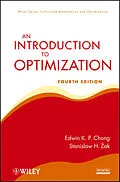Praise for the Third Edition ". . . guides and leads the
reader through the learning path . . . [e]xamples are stated very
clearly and the results are presented with attention to
detail." --MAA Reviews
Fully updated to reflect new developments in the field, the
Fourth Edition of Introduction to Optimization fills
the need for accessible treatment of optimization theory and
methods with an emphasis on engineering design. Basic definitions
and notations are provided in addition to the related fundamental
background for linear algebra, geometry, and calculus.
This new edition explores the essential topics of unconstrained
optimization problems, linear programming problems, and nonlinear
constrained optimization. The authors also present an optimization
perspective on global search methods and include discussions on
genetic algorithms, particle swarm optimization, and the simulated
annealing algorithm. Featuring an elementary introduction to
artificial neural networks, convex optimization, and
multi-objective optimization, the Fourth Edition also
offers:
* A new chapter on integer programming
* Expanded coverage of one-dimensional methods
* Updated and expanded sections on linear matrix inequalities
* Numerous new exercises at the end of each chapter
* MATLAB exercises and drill problems to reinforce the discussed
theory and algorithms
* Numerous diagrams and figures that complement the written
presentation of key concepts
* MATLAB M-files for implementation of the discussed theory and
algorithms (available via the book's website)
Introduction to Optimization, Fourth Edition is an ideal
textbook for courses on optimization theory and methods. In
addition, the book is a useful reference for professionals in
mathematics, operations research, electrical engineering,
economics, statistics, and business.
Autorentext
Edwin K. P. Chong, PHD, is Professor of Electrical and
Computer Engineering as well as Professor of Mathematics at
Colorado State University. He is a Fellow of the IEEE and Senior
Editor of IEEE Transactions on Automatic Control.
Stanislaw H. Zak, PHD, is Professor in the School of
Electrical and Computer Engineering at Purdue University. He is
former associate editor of Dynamics and Control and IEEE
Transactions on Neural Networks
Zusammenfassung
Praise for the Third Edition ". . . guides and leads the reader through the learning path . . . [e]xamples are stated very clearly and the results are presented with attention to detail." MAA Reviews
Fully updated to reflect new developments in the field, the Fourth Edition of Introduction to Optimization fills the need for accessible treatment of optimization theory and methods with an emphasis on engineering design. Basic definitions and notations are provided in addition to the related fundamental background for linear algebra, geometry, and calculus.
This new edition explores the essential topics of unconstrained optimization problems, linear programming problems, and nonlinear constrained optimization. The authors also present an optimization perspective on global search methods and include discussions on genetic algorithms, particle swarm optimization, and the simulated annealing algorithm. Featuring an elementary introduction to artificial neural networks, convex optimization, and multi-objective optimization, the Fourth Edition also offers:
- A new chapter on integer programming
- Expanded coverage of one-dimensional methods
- Updated and expanded sections on linear matrix inequalities
- Numerous new exercises at the end of each chapter
- MATLAB exercises and drill problems to reinforce the discussed theory and algorithms
- Numerous diagrams and figures that complement the written presentation of key concepts
- MATLAB M-files for implementation of the discussed theory and algorithms (available via the book's website)
Inhalt
Preface xiii
PART I MATHEMATICAL REVIEW
1 Methods of Proof and Some Notation 3
1.1 Methods of Proof 3
1.2 Notation 5
Exercises 6
2 Vector Spaces and Matrices 7
2.1 Vector and Matrix 7
2.2 Rank of a Matrix 13
2.3 Linear Equations 17
2.4 Inner Products and Norms 19
Exercises 22
3 Transformations 25
3.1 Linear Transformations 25
3.2 Eigenvalues and Eigenvectors 26
3.3 Orthogonal Projections 29
3.4 Quadratic Forms 31
3.5 Matrix Norms 35
Exercises 40
4 Concepts from Geometry 45
4.1 Line Segments 45
4.2 Hyperplanes and Linear Varieties 46
4.3 Convex Sets 48
4.4 Neighborhoods 50
4.5 Polytopes and Polyhedra 52
Exercises 53
5 Elements of Calculus 55
5.1 Sequences and Limits 55
5.2 Differentiability 62
5.3 The Derivative Matrix 63
5.4 Differentiation Rules 67
5.5 Level Sets and Gradients 68
5.6 Taylor Series 72
Exercises 77
PART II UNCONSTRAINED OPTIMIZATION
6 Basics of Set-Constrained and Unconstrained Optimization 81
6.1 Introduction 81
6.2 Conditions for Local Minimizers 83
Exercises 93
7 One-Dimensional Search Methods 103
7.1 Introduction 103
7.2 Golden Section Search 104
7.3 Fibonacci Method 108
7.4 Bisection Method 116
7.5 Newton's Method 116
7.6 Secant Method 120
7.7 Bracketing 123
7.8 Line Search in Multidimensional Optimization 124
Exercises 126
8 Gradient Methods 131
8.1 Introduction 131
8.2 The Method of Steepest Descent 133
8.3 Analysis of Gradient Methods 141
Exercises 153
9 Newton's Method 161
9.1 Introduction 161
9.2 Analysis of Newton's Method 164
9.3 Levenberg-Marquardt Modification 168
9.4 Newton's Method for Nonlinear Least Squares 168
Exercises 171
10 Conjugate Direction Methods 175
10.1 Introduction 175
10.2 The Conjugate Direction Algorithm 177
10.3 The Conjugate Gradient Algorithm 182
10.4 The Conjugate Gradient Algorithm for Nonquadratic
Problems 186
Exercises 189
11 Quasi-Newton Methods 193
11.1 Introduction 193
11.2 Approximating the Inverse Hessian 194
11.3 The Rank One Correction Formula 197
11.4 The DFP Algorithm 202
11.5 The BFGS Algorithm 207
Exercises 211
12 Solving Linear Equations 217
12.1 Least-Squares Analysis 217
12.2 The Recursive Least-Squares Algorithm 227
12.3 Solution to a Linear Equation with Minimum Norm 231
12.4 Kaczmarz's Algorithm 232
12.5 Solving Linear Equations in General 236
Exercises 244
13 Unconstrained Optimization and Neural Networks 253
13.1 Introduction 253
13.2 Single-Neuron Training 256
13.3 The Backpropagation Algorithm 258
Exercises 270
14 Global Search Algorithms 273
14.1 Introduction 273
14.2 The Nelder-Mead Simplex Algorithm 274
14.3 Simulated Annealing 278
14.4 Particle Swarm Optimization 282
14.5 Genetic Algorithms 285
Exercises 298
PART III LINEAR PROGRAMMING
15 Introduction to Linear Programming 305
…